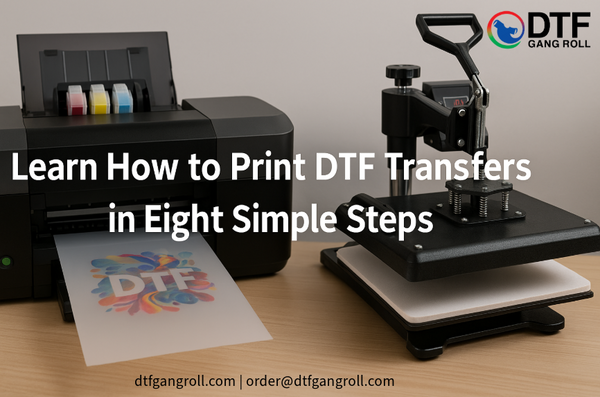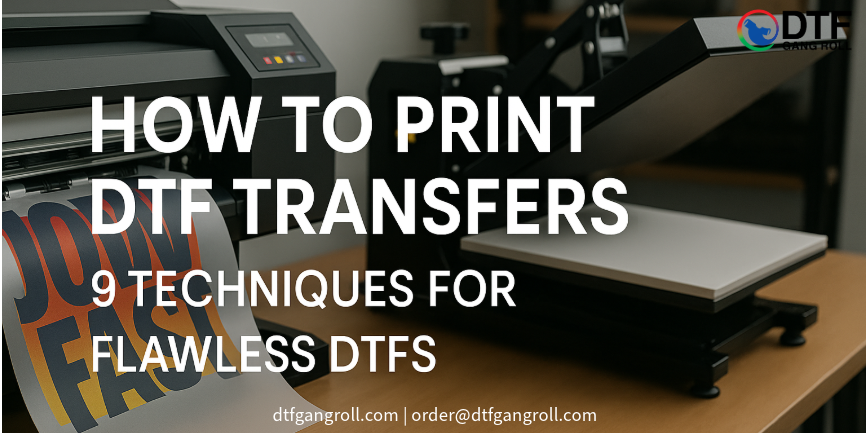DTF (Direct to Film) transfers are a popular printing technique for creating high-quality, vibrant, and durable designs on various fabrics, including cotton, polyester, and blends. This method involves printing designs onto a special film using a DTF printer, which is then transferred onto the fabric using a heat press machine.
DTF transfers offer a wide range of benefits, including bright colors, fine details, and excellent durability, making them an ideal choice for garment printing, promotional products, and other applications. Whether working with cotton, polyester, or a blend, DTF transfers ensure your designs stand out with vivid colors and intricate details.
Understanding DTF Printing
DTF printing is a unique process that involves printing designs onto a special film using a DTF printer. The film is coated with a layer of adhesive powder, which is then applied to the fabric using a heat press machine. The heat press process melts the powder, bonding the design to the fabric.
DTF printing offers excellent print quality, vibrant colors, and fine details, making it an ideal choice for creating high-quality DTF transfers. To achieve optimal results, it’s essential to use high-quality DTF ink, follow the recommended temperature and pressure settings, and use the correct file format. This ensures that your designs are not only visually stunning but also durable and long-lasting.
Setting Up for DTF Printing
To set up for DTF printing, you’ll need a few essential pieces of equipment, including a DTF printer, a heat press machine, and DTF film. You’ll also need to choose the right DTF ink and adhesive powder for your specific application.
When setting up your DTF printer, follow the manufacturer’s instructions and adjust the settings according to your specific needs. It’s also essential to preheat your heat press machine to the recommended temperature and use medium pressure to ensure optimal results. Proper setup is crucial for achieving high-quality prints and ensuring the longevity of your equipment.
Learn How to Print DTF Transfers in Eight Simple Steps
The Direct-to-Film (DTF) printing industry is surging at a phenomenal pace. According to Research and Markets, the global DTF industry reached approximately $2.72 billion in 2024 and is likely to grow at a 6.5% CAGR to $3.99 billion by 2030.

To participate in this booming DTF economy, you must know how to print DTF transfers correctly. In this article, you will find a step-by-step guide. It covers pro-level strategies for printing great designs. With these tips, you can build a business that lasts.
Step 1: Start with High-Quality Artwork
DTF professional printing begins with the design. Using Adobe Illustrator and Adobe Photoshop is recommended for creating high-resolution artwork. Your art must be high resolution (ideally 300 DPI or greater) to yield clean and vivid colors. Vector formats (.AI or .SVG) are ideal, but high-resolution PNGs or TIFFs could also work.
Adobe Illustrator is particularly useful for its high-resolution capabilities and compatibility with various file types. Adobe Photoshop is essential for preparing high-resolution artwork suitable for DTF printing.
Pro Tip: To ensure your artwork’s integrity during the process:
- Utilize CMYK color profiles for improved print accuracy.
- Don’t use low-resolution JPEGs or overly compressed files; they can create pixelated results.
- Add a white underbase layer to your design for dark clothing if your RIP software requires it.
Step 2: Use Professional-Quality DTF Ink and Film
The quality of the ink and powder directly affects the outcome. Invest in good-quality PET film or special film for DTF designed for use in the DTF printing process. It should be matte or semi-matte coated to retain the quality of the ink.
Pro Tip: Match the film with DTF-specific pigment inks that are stretchy and wash-durable. Low-quality powder or white ink can lead to cracked or faded colors that may not last very long.
Step 3: Get the Powder Adhesive Application Perfect
Once your design is on the film, the next step is to apply the DTF powder or hot melt powder. This helps bond the design to the textile. Be sure to apply evenly to prevent a messy finish or poor adhesion.
Ensuring the DTF powder completely covers the entire image is crucial for optimal adhesion and design clarity.
Pro Tips:
- While the ink is still damp, apply the powder across the print.
- Shake off excess powder without disturbing the ink.
- Use a curing oven or heat press method to melt the adhesive powder.
Step 4: Optimize Your Heat Press Settings
Your heat press machine and the settings are the workhorse of the DTF application. Therefore, follow the standard heat press setting for DTF transfers:
- Temperature around 300°F to 320°F (149°C to 160°C)
- Pressure from medium to firm
- Time around 15–20 seconds
It is crucial to double-check your heat and press time settings to avoid problems like uneven transfers and ensure a flawless transfer process.
Pro tip: Pre-press your garment for 5 seconds to draw out moisture and flatten wrinkles. It makes the transfer adhere better.
Step 5: Choose your Peel: Hot vs. Cold Peel
Depending on the film you choose, you may need to use cold peel or hot peel. For cold peel, let the film cool before removing it. For hot peel, remove it right after pressing. Follow the manufacturer's instructions for optimum results.
Pro Tip: Do a final cure press after peeling off the film to enhance wash resistance and longevity.
Step 6: Cover with Parchment or Teflon Sheet
Press again for 5–10 seconds at 300°F–320°F. Curing embeds the adhesive completely into the textile and sets the ink.
Step 7: Choose the Right Fabric for DTF Printing
One of the best things about DTF is that it works on many types of fabrics, such as t-shirts, which are ideal for DTF transfers. Some materials perform better than others, though.
Ensuring color accuracy when printing on t-shirts is crucial to achieve vibrant and accurate designs.
- Choose from the following fabrics if unsure:
- Cotton: Excellent ink uptake and print sharpness.
- Cotton/Poly Blends: Excellent durability vs. smoothness ratio.
- 100% Polyester: Best for light-colored prints; requires mild underbase treatment.
- Tri-blends: Nice feel and hold if treated lightly.
Pro Tip: Avoid highly textured or treated materials such as nylon, which can interfere with the adhesive bonding.
Learn more about how to Choose Fabrics and Blank Apparel for DTF.
Step 8: Control Your Environment
Reliable, consistent, and quality outcomes are heavily dependent on a controlled environment. Temperature and humidity affect how powder cures and how ink behaves. This is why it is very important to control your environment.
Ideal conditions for the printing process:
- Check that the temperature is around 68–75°F (20–24°C).
- Check that the humidity level is around 40–60%.
Keep your workspace clean and free of debris. This helps stop dirt or other impurities from getting on wet prints or powder.
Pro Tip: Use a hygrometer or thermometer to check the room temperature. Even small changes can lead to big problems in print quality.
Step 9: Calibrate Your Printing Equipment
A quality image depends on the design software, but how it appears on the fabric depends on the DTF machine. Using high-resolution images is crucial for achieving a quality image. In order to create a color-rich design, you need to make sure of a few things about your DTF printers:
-
The printer heads are aligned
-
The ink flow is steady
-
The heat press is set for precise heat
Additionally, adjusting other settings in the printing software, such as ink density and print resolution, is important for optimal results.
Pro tip: Regularly use test prints and check printed film. An uneven press can make parts of the image lift or wash away too soon.
Film Transfer Process
The film transfer process involves applying the DTF transfer to the fabric using a heat press machine. To do this, place the transfer film on the fabric, making sure to align it correctly, and then apply the heat press. The heat press process will melt the adhesive powder, bonding the design to the fabric.
Once the transfer is complete, carefully peel off the transfer film, and your DTF transfer is ready. To achieve optimal results, make sure to use the correct temperature and pressure settings and peel the film slowly to avoid damaging the design. This careful approach ensures that your designs are transferred perfectly every time.
Troubleshooting Common Issues
When working with DTF transfers, you may encounter common issues, such as excess powder, ink smudging, or uneven adhesion. To troubleshoot these issues, check your equipment and settings and adjust them according to your specific needs.
For example, if you’re experiencing excess powder, try reducing the amount of powder applied to the film. If you’re experiencing ink smudging, try adjusting the heat press settings or using a different type of DTF ink.
By following these tips and troubleshooting common issues, you can achieve professional results with your DTF transfers. Regular maintenance and careful monitoring of your equipment can prevent many of these issues, ensuring consistent, high-quality prints.
Parting Words
Learning to print quality designs can be tough. Pro-grade DTF screen printing requires more than just placing a transfer on a shirt. It requires the best materials, advanced-level DTF skills, and meticulous procedures to learn how to print DTF transfers.
Creating your own DTF transfers involves using a DTF transfer printer, DTF ink, transfer film, and a heat press, following specific steps to ensure successful transfers. The pressing process is crucial for achieving quality prints and ensuring the durability of the transfers through multiple washes.
To print quality transfers, start with clean, high-resolution art. Use the best film, ink, and powder. Calibrate your heat press. Choose fabrics that work well together. Perfect the curing process. Test for quality before you begin. With attention to detail and patience, you can press DTF transfers that will make your business stand out.

